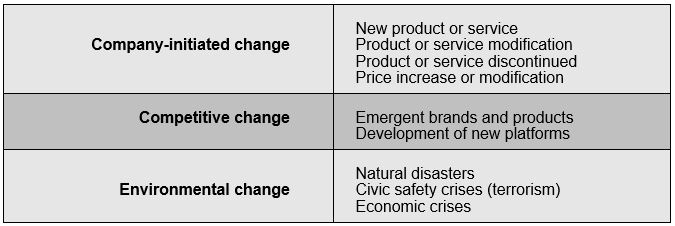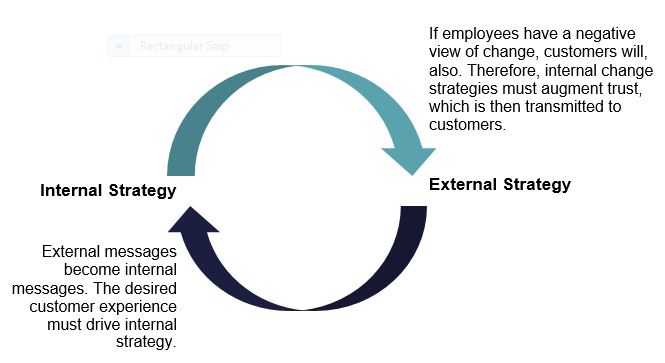Experience-Based Messaging Model
To build trust, businesses
|
While extensive literature today informs us of how to lead change internally, fewer best practices exist for managing external change.
Moving From Brand to Trust
The late Stephen Covey said, seek to understand, and then be understood. By nature of this flow of information, communicating and demonstrating trust requires that we listen first and communicate second. Brand, by contrast, sets business goals first and then targets those messages to select customers.
Brand in essence is something that a company projects, whereas trust is an exchange of information and perspectives. For example, a company may see a product change as an enhancement and a customer may perceive that enhancement as an inconvenience.
To build trust, businesses and business leaders no longer broadcast their messages. Instead, they seek to establish trust through relational activities that say, “We’re listening and we value your opinion.”
BRAND MODEL
The direction and flow of information is inside-out. From our leadership comes business goals that drive product goals that drive messaging goals.
1. Set Business Goals
2. Assess Market Environment & Customers’ Needs
3. Customize And Target Brand Messages
TRUST MODEL
When trust is the goal, companies listen first and talk second. Understanding the customer becomes the central tenet of an effective communications program. The direction and flow of information, therefore is outside-in.
1. Listen*
2. Refine business goals
3. Develop trust-building communication strategy
*Listening strategies: The trust model’s listening component is open to interpretation and highly customizable. External listening devices are often most effective when used in combination. That said, each company should select listening methods.
Listening Is the Bedrock Of Trust
Traditional listening methods stem from command-and-control management strategies, when companies only wanted to hear from customers in order to refine product and marketing strategies. These traditional methods include focus groups, customer surveys and polls. In each instance, the company decides what information to gather, which questions to ask, and how to frame those questions.
Open listening transfers more power and influence to customers. Instead of framing customer insight through the lens of a business’ objectives, customer perspectives help influence and frame business goals. This customer-centric approach requires companies to have a deep psychological understanding of their customers, such as the information gleaned from a mindset archetype. Additional methods that empower customers include social media, online engagement and analytics, and qualitative information gathered through sales and customer support channels.
One important distinction among these methods: only the mindset archetypes are designed to span organizational silos and provide insights that can be immediately applied to any customer strategy. Other data sources tend to reside in specific functional areas, decreasing the business’ ability to consider events and changes from their customers’ perspectives.
Finally, in the event of a crisis, control-based listening tactics become largely useless. When a crisis hits, there is no time to conduct a poll. Employees from departments as diverse as PR and legal need immediate and unrestrained access to customer perspectives.
How Customers Experience Change
While extensive literature exists on how employees experience change, little is written to describe how customers experience change. The field of customer experience strategy is possibly the best resource for understanding how customers process and experience the things a business says and does. However, there is no standardized model such as ADKAR, which governs internal change management.
Nonetheless, a failure to effectively communicate change and to manage customers’ expectations in the process, is a common and crippling form of business error. While some business changes are immediately embraced and celebrated, they are rare.
Types of change that customers experience
The Customer Change Curve
The change curve is a fixture in discussions of internal change management strategies and is largely based on research from Elizabeth Kubler-Ross on the five stages of processing loss. It follows that the relevance of the change curve depends on whether customers experience any form of loss – or a perception of loss. If their perception is only positive, then the change curve does not apply.
This change curve is designed to demonstrate how customers experience change. Considering that the goal is to promote customer loyalty and advocacy, companies need to actively avoid the first two stages in customers’ experience of change.
Objectives for Customer Change Communication
- Avoid the perception of loss. People feel disappointed when the service they felt comfortable using suddenly becomes new and unfamiliar.
- Increase customers’ choice. Empower customers as they process change. A lack of choice can feel constraining.
- Embrace transparency. Educate customers about the business goals (or shifting customer expectations) that necessitated the change. Educate customers about their benefits, even if the benefits seem obvious.
- Be honest. If customers later realize that your true goals don’t align with your stated goals, trust and confidence will be compromised.
- Customer perceptions should become your perceptions. Perceptions govern all relationships, including relationships between companies and customers.
Continuously learning about change
When employees are aligned with customers during change, they are able to perceive changes through customers’ perspectives. The tighter these two stakeholder groups become, the more employees are able to deliver a trust-enhancing customer experience in all market environments, and especially during change.
Read more and purchase the Experience-based Messaging Model by clicking here.





